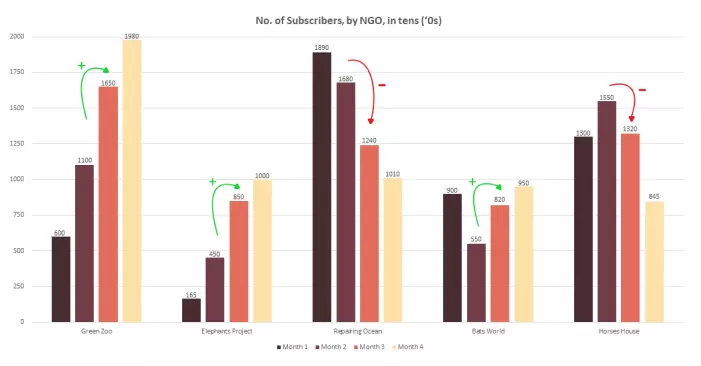 EY Job Simulation – The Complete Guide for Your EY Consulting Assessment [2025]
EY Job Simulation – The Complete Guide for Your EY Consulting Assessment [2025]
The EY Job Simulation, also called EY Consulting Assessment, is part of Ernst & Young’s Business Consulting service line recruitment process.
As a job simulation, the assessment mimics real work-related scenarios you may experience once joining Ernst & Young.
The test assesses your cognitive abilities, work-related preferences, and tendencies to ensure you fit into a consulting role at EY.
Our EY Job Simulation preparation pack is designed to equip you with the essential practice required to ace the test and secure a place in EY’s Graduate Programme. It includes:
Are you applying for other service lines? Visit our EY Online Assessments page for more information, or find your test in the EY Assessments table below.
The PrepPack™ Includes:
- Full EY Job Simulation-style test:
- 10 Your Thinking Questions
- 3 Making Connections Questions
- 3 Solving Problems Questions
- 3 Developing Solutions Questions
- 3 Implementing Change Questions
- 5 Pre-Recorded Interview (Why EY) Questions
- Study guides:
- Introduction Guide
- Interactive Pre-Recorded Interview Guide
- Written Responses Guide
What Is the EY Job Simulation?
The EY Consulting Assessment is a job simulation designed to give you an insight into what it looks like to work at EY within the Consulting line of service.
The questions will come in different forms, including strengths-based scenarios, problem-solving, and numerical reasoning. They can be multiple-choice, open-ended, in which you will need to insert a written answer, or video and audio responses to which you will need to record your answer via your webcam.
The assessment is provided by Cappfinity and comprises six sections –
- Your Thinking
- Making Connections
- Solving Problems
- Developing Solutions
- Implementing Change
- Why EY
Apart from the pre-recorded interview, the EY Job Simulation has no time limit and takes about 1 hour to complete.
Let’s take a closer look at each of the sections!
Looking For Other Finance Tests?
HSBC | UBS | Bain & Co | Macquarie | Morgan Stanley | Barclays | EIB | Deloitte | Deutsche Bank | KPMG | PWC | Credit Suisse | Nomura | BCG | BNP Paribas | Jefferies | Summer Internships | Spring Week | Job Simulation
Your Thinking
This section of the EY Job Simulation evaluates your approach to interpreting business information and numerical data.
You will be given 6 sources with different types of data, followed by a series of numerical reasoning questions, both multiple and open-ended.
There are 10 questions to complete with no time limit.
Let’s see how it looks –
EY Job Simulation – Your Thinking Sample Question
Which of the following NGOs had the second-highest percentage increase in subscribers to updates from Month 2 to Month 3?
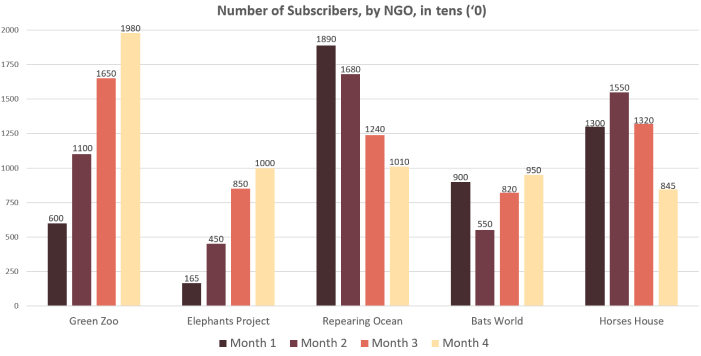
Making Connections
This section of the EY Job Simulation evaluates your ability to connect and create relationships with colleagues and clients.
You will be presented with two emails containing information regarding your work-related tasks and assignments, which involve communication with other people.
Afterwards, you will be given 3 scenarios that you will need to respond to by ranking the order of several possible options according to what you are most likely to do or through a video or audio recording. In these cases, you will have up to 3 minutes to prepare your response and 2 minutes to record it.
Let’s see an example!
EY Job Simulation – Making Connections Sample Question
You are a member of a team assigned the task of researching the potential of your company to expand to a new market. You will need to present the results of your research by the end of the week to your manager. The week has nearly ended and it seems your team will not make it in time. Your job is to review relevant websites and gather contact information for potential big clients.
Rank the following responses on a 1-5 scale (1= least effective; 5= most effective). Each ranking can be used only once.
Gather your team and assess how much extra time you will need for the presentation.
| 1 | 2 | 3 | 4 | 5 |
Challenge your team so that you all finish your parts on time.
| 1 | 2 | 3 | 4 | 5 |
Be optimistic and keep working. Perhaps you won’t miss the deadline after all.
| 1 | 2 | 3 | 4 | 5 |
Make sure you gather your part of the data before the week is over.
| 1 | 2 | 3 | 4 | 5 |
Suggest that your team should finish the presentation next week instead.
| 1 | 2 | 3 | 4 | 5 |
Ranking questions are particularly difficult due to the need to discover nuances between similar answer choices. In addition, the questions test for multiple competencies that are desirable by employers. A good strategy would be first to identify which choices seem negative, and which seem positive, and only then try to rank them. Here, the question tests your ability to show you care for your team’s performance as well as your desire to accomplish the tasks you have been given in a team context.
Response E is the least effective response. Note that although it seems you are offering a solution to the problem by suggesting a new deadline, you are actually showing a potential employer that you are flexible about your deadlines. By this, you are also showing that you are not responsible, not focused on achievement, and lack optimism. This is why response C is considered better than response E; it employs more optimism and seeks to finish the task by the deadline despite that being unrealistic. The option of delaying the task for next week still exists even if you try to continue working on the task.
Although response D doesn’t explicitly talk about optimism, it shows that you are optimistic by focusing on actively completing your part of the task. Doing so shows that you are reliable (responsible) and will continue to work despite the difficulty. Response D is better than response C as it is more active and focuses on effective action. As good teamwork is dependent upon each member contributing his part, making sure you do yours is a moderately effective response.
Response A is more effective than response C. This response is more effective as it employs more teamwork; you are trying to solve the problem as a team. Since you are actively trying to gather information and re-organize the team, this is an effective response to the problem.
Response B is the most effective response. It exemplifies optimism and shows you understand that the team’s success as a whole is important. This then demonstrates good teamwork potential. By trying to inspire your team, you are also showing your ability to influence co-workers (persuasion) as well as an orientation towards achieving better results (achievement).
Although this option doesn’t exist, note that an ideal response to this problem would be a combination of choices A & B: gathering the team to understand what the best approach to meeting the deadline would be, along with motivating the group to meet the deadline as a team.
Solving Problems
This section of the EY Job Simulation evaluates your ability to approach assignments, analyse information, and come up with the necessary solutions.
You will be given 8 sources of information, including emails from your colleagues, reports, charts, and graphs containing data.
Afterwards, you will be given 3 scenarios that you will need to respond to by writing your answer, ranking the order of several options according to what you are most likely to do, or through a video or audio recording. In these cases, you will have 2.5 minutes to prepare your response and 2 minutes to record it.
Let’s take a look!
EY Job Simulation – Solving Problems Sample Question
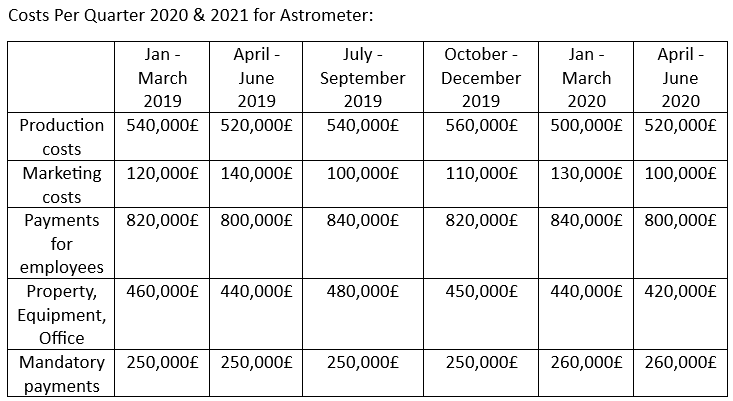
Please write a summary of the table above.
In our EY Job Simulation PrePack™, you will find guiding instructions that will teach you how to approach these types of questions and an example showing you how to respond to each of them.
Developing Solutions
This section of the EY Job Simulation evaluates your critical thinking skills and your ability to solve problems.
You will be given 6 sources of information, including reports, charts, and graphs containing data.
Afterwards, you will be presented with 3 scenarios to respond to by ranking the order of several options according to what you are most likely to do, or through a video or audio recording. In these cases, you will have 2.5 minutes to prepare your response and 2 minutes to record it.
Let’s try one!
EY Job Simulation – Making Connections Sample Question
You recently joined EY as an intern and will attend your first team meeting.
How would you approach the meeting to make a positive impression and contribute effectively?
Rank order the options below, with 1 being the approach you are most likely to take and 5 being the approach you are least likely to take.
Offer assistance to team members when appropriate, showing eagerness to learn and contribute to the team's goals.
| 1 | 2 | 3 | 4 | 5 |
Ask thoughtful questions that demonstrate your interest in the subject matter and your willingness to learn from experienced colleagues.
| 1 | 2 | 3 | 4 | 5 |
Seek feedback from your supervisor or more experienced team members after the meeting to further improve your performance.
| 1 | 2 | 3 | 4 | 5 |
Share any relevant ideas or insights you may have, even if they are tentative or based on limited experience.
| 1 | 2 | 3 | 4 | 5 |
Take notes during the meeting and actively listen to gain a thorough understanding of the discussions and tasks at hand.
| 1 | 2 | 3 | 4 | 5 |
The best ranking in this scenario is –
1. Take notes during the meeting and actively listen to gain a thorough understanding of the discussions and tasks at hand.
2. Offer assistance to team members when appropriate, showing eagerness to learn and contribute to the team's goals.
3. Ask thoughtful questions that demonstrate your interest in the subject matter and your willingness to learn from experienced colleagues.
4. Share any relevant ideas or insights you may have, even if they are tentative or based on limited experience.
5. Seek feedback from your supervisor or more experienced team members after the meeting to further improve your performance.
Included in our PrePack is an interactive SJT guide that provides detailed explanations on how to best respond to each scenario based on the specific position you have applied for.
Implementing Change
This section of the EY Job Simulation evaluates your ability to adapt and implement changes, such as new technologies and working methods.
You will be given 2 sources of information, which include an email from your colleague and an article about technological developments.
Afterwards, you will be presented with 3 scenarios you will need to respond to by writing your answer or ranking the order of several approaches according to what you are most likely to take.
Let’s see an example!
EY Job Simulation – Implementing Change Sample Question
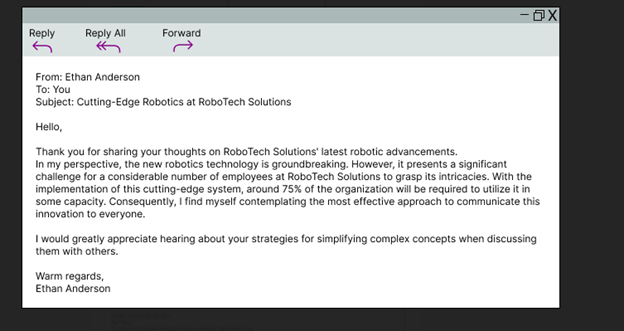
Please compose a response email to Ethan outlining the strategies you have.
*You have a limit of a maximum of 1000 words
Our PrePack provides instructional guidelines tailored especially for the EY Job Simulation, with a specific section regarding email response and word count limits!
Why EY
This section of the EY Job Simulation is a one-way video interview, also known as a pre-recorded interview, which aims to learn more about you and the reasons for joining EY.
You will be presented with a series of 5 HR-style questions.
You will have 2 minutes to prepare your response and 2 minutes to record it.
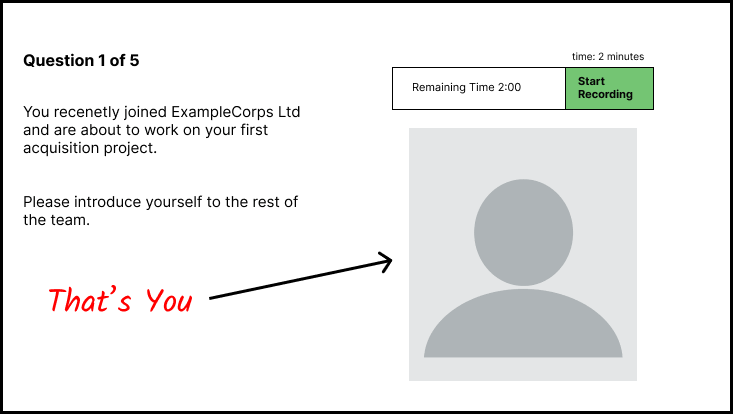
EY Pre-Recorded Interview Questions
The questions you will encounter in your EY pre-recorded interview may vary depending on the specific position you have applied for. However, they will usually focus on gathering general information about your motivations, enthusiasm for the role, and potential contributions to both the position and the organisation.
The questions you may be asked can include:
- Why are you interested in a position in consulting?
- What strengths do you have that will help you to succeed in this position?
- How would you stay motivated to balance work and learning simultaneously?
- What research have you done to prepare for a role in consulting at EY?
- Explain why you have chosen to apply for this location.
While it may not be conducted in person, it is important to approach your pre-recorded interview with the same level of professionalism as a traditional face-to-face interview. Remember that recruiters will review your recording, so it is crucial to dress appropriately, maintain eye contact with the camera, and demonstrate familiarity with the organisation, the consulting line of service, and the specific role you have applied for.
💡 Learn more about Pre-Recorded Interviews
EY Assessment Tests
EY provides a range of graduate programmes across various service lines, including Tax, Consulting, Assurance, Technology, Strategy and Transactions, and Law. The recruitment process for each service line involves one or more assessment tests specifically designed for that particular line of service.
💡 Learn which tests you will be taking for EY below:
| Service Line | EY Assessment Tests |
| ✻ Assurance | Numerical reasoning |
| ✻ Tax | Numerical reasoning EY One Assessment |
| ✻ Consulting | Business consulting: EY One Assessment Technology consulting |
| ✻ Law | Technology is Changing Our World |
| ✻ Strategy & Transactions | Technology is Changing Our World |
| ✻ Technology | Numerical Reasoning |

Prepare for the EY Consulting Assessment with JobTestPrep's tailored PrePack, which includes a full simulation, detailed answers and explanations, and study guides to help you to ace the test and save your spot in the EY programme!
Are you applying for EY Australia? JobTestPrep is currently developing a preparation plan for the EY Australia Assessment – for more details, ✉ contact us! ✉

